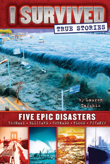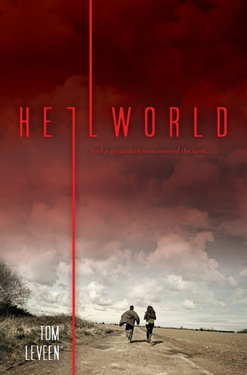
The ‘Killer Pizza’ Series by Greg Taylor
Here is an especially horror-filled series of books that will leave you shivering and hungry. High School


Five Epic Disasters (I Survived True Stories #1)
The I Survived series brings us five horrifying stories featuring real kids in the midst of epic disasters.
The Childrens Blizzard, 1888
After weeks of being trapped in their houses, the temperature was -40 degrees; everyone was excited when the temperature changed to 20 degrees. It was almost springlike. Nobody knew that the worst blizzards in history was about to strike.
People back then were crazy to live on the prairie. Not just because of the weather but because of the grasshoppers. Swarms containing billions of insects could destroy an entire farms work in a matter of hours.
Cool Fact: The difference between a snowstorm and a blizzard is wind, not the amount of snow. Blizzards have strong winds that blow snow, making it hard to see. Otherwise, its just a regular old snowstorm.
The Titanic, 1912
A really expensive ship, the ship hits an iceberg, lots of people died, some people lived, a movie was made. We all know the story so lets move on.
An unfortunate disaster that probably could have been prevented, blah, blah, blah. I know I sound insensitive, but we all know the story by now.
Cool Fact: The most expensive ticket was about $4,500, equivalent to about $103,000 in todays dollars.
The Great Boston Molasses Flood, 1919
In Bostons North End, a molasses tank exploded under pressure, killing 21 people. Structural defects in the tank combined with unseasonably warm temperatures contributed to the disaster.
Why am I just now hearing about this disaster? Why did I not learn about this in history class?
Cool Fact: Heated up in a process called distillation, molasses can be turned into a liquid called industrial alcohol. In this form, molasses became a key ingredient in the explosives used in the war against Germany.
The Japanese Tsunami, 2011
The events of March 11, 2011, are now known as the Great Tohoku Earthquake and Tsunami. It was actually 3 terrible disasters bundled together the powerful quake, the hundreds-miles-wide tsunami, and the ongoing nuclear disaster.
Even after reading about three high school kids who survived this disaster, I still have no idea how anyone could survive this.
Cool Fact: Tsunami is a Japanese word meaning harbor wave.
The Henryville Tornado, 2012
The idea to write about this specific tornado came from three 5thgrade girls who wrote Lauren Tarshis about how their school and their town was destroyed by a massive tornado.
Nothing like a natural disaster to bring a community together.
Cool Fact: The word TORNADO comes from two Spanish words: tornar, which means to turn, and tronada, which means thunderstorm.
Nature Attacks! (I Survived True Stories #2)
The I Survived series brings up four more terrifying tales of real kids up against terrible forces of nature.
Summer of Terror: The True Story of the Shark Attacks of 1916
The people of New Jersey learn the hard way that sharks arent as tame as assumed back when the oceans were as mysterious as distant galaxies.
This chapter gives us more information about the shark attacks and what life was like during these shocking events.
Cool Fact: A person is more likely to be killed by a coconut falling on their head than by a shark.
The Volcano that Changed the World: The Eruption of Mount Tambora, 1815
Learn how a volcanic eruption in Indonesia caused weather disasters worldwide.
I was surprised to learn that the deadliest volcanic eruption in recorded history was Mount Tambora. I wouldve guessed Pompeii was.
Cool Fact: The tallest volcano in the solar system is on Mars. Olympus Mons is 15.5 miles high.
The Bloodred Night: The Great Peshtigo Fire of 1871
On the night of October 8, 1871, Peshtigo, a booming town of 1,700 people, was wiped out of existence in the most significant forest disaster in American history. The same time as the Great Chicago Fire.
Learning about how many trees were cut down in this once beautiful Wisconsin forest made me sad.
Cool Fact: Lightning causes 10% of all wildfires. About 90% of wildfires are caused by humans. Campfires, sparks caused by machinery, and cigarette smoking are most to blame.
The Invisible Monster: One Girls Encounter with the Deadly Box Jellyfish
It was the year 2009 in Australia when a 10-year-old girl was nearly killed by a nearly invisible creature, the box jellyfish. We learn about the most deadly and venomous animals on earth. Australia is the world capital of deadly creatures, from eastern brown snakes to cassowaries.
Dont worry, everyone. The girl who was stung is alive and well. These are I Survivedbooks, after all.
Cool Fact: Each tentacle on a box jellyfish is armed with half a million microscopic harpoons called nematocysts, which are loaded with powerful venom.
Extreme Weather (I Survived True Stories #3)
The true stories of these two events plus fascinating facts, profiles of tornado scientists, and storm chasers.
Everyone Must Be Dead: The Tri-State Tornado of 1925
To this day, the Tri-State Tornado remains the deadliest single tornado ever to strike the U.S. The disaster shocked the world and helped change ideas about the dangers of tornados.
On a lighter note, one of the towns the tornado went through is called Murphysboro. Funny name, huh?
Cool Fact: 235 miles – length of tornados path of destruction, 300 MPH estimated speed of winds, 695 number of people killed
The Evil Swirling Darkness: The Joplin Tornado of 2011
Joplin is a small city that sits near where 3 states meet: Missouri, Arkansas, and Kansas. Lauren Tarshis wrote about Joplin before, but now she goes into more detail.
It was sad that it took a second tornado warning alarm for people in Joplin to realize it wasnt a false alarm.
Cool Fact: 13 miles length of tornados path of destruction, 200 MPH speed of winds, 161 number of people killed
The American Revolution, 1776 (I Survived, #15)
Nathaniel Fox has barely paid attention to the troubles between America and England. How could he, while being worked to the bone by his cruel uncle? When his uncles rage forces him to flee, Nate is propelled toward a dangerous journey into the Revolutionary War.
I was surprised that Lauren Tarshis wrote about the American Revolution because its such a big topic. She even said that she couldve written fifty books on the subject. I wonder what disaster shell write about next. Im hoping for a snowstorm.
Cool Fact: The War officially began in Lexington and Concord on April 19, 1775. The war dragged on for eight years until September 1783.

Here is an especially horror-filled series of books that will leave you shivering and hungry. High School

HAPPY 150TH BOOK REVIEW And to celebrate, here is a book of short horror stories written specifically for young readers. 5 to 95 (Suggested for

High School Sixteen-year-old Sarah Meadows longs for normal. Born with a port-wine stain covering half her face, shes been plagued by stares, giggles, bullying, and

Here is an especially horror-filled series of books that will leave you shivering and hungry. High School

HAPPY 150TH BOOK REVIEW And to celebrate, here is a book of short horror stories written specifically for young readers. 5 to 95 (Suggested for all readers) Featuring twenty-six terrifying short stories, each based on a different A to Z

High School Sixteen-year-old Sarah Meadows longs for normal. Born with a port-wine stain covering half her face, shes been plagued by stares, giggles, bullying, and disgust all her life. But when shes abducted on the way home from school, Sarah

HAPPY OCTOBER! To celebrate October, heres a hell-raising story to get us in the Halloween mood. Pun intended. High School Five years ago, Abby Booths mom, co-host of a ghost-hunting reality show, went missing while filming in a haunted cave


Albert, Houdini & Maddie
Copyright © 2021 Amazing Artists Online – All Rights Reserved
Developed by Clearian
Copyright © 2023 Amazing Artists Online – All Rights Reserved
Developed by Clearian